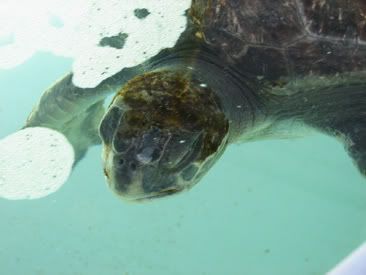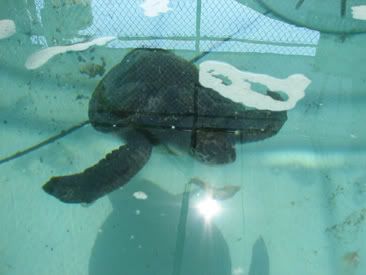
A seafood platter of sushi-grade clams, squid and shrimp are tossed by the handful into a pool, hidden behind the Aquarium of the Pacific. A dark figure lies on the bottom, coming to life when lunch hits the surface. It turns and glides toward the nearest clam, scooping it up in its beak and gulping it down. It ascends to the surface for a quick breath, and then you can see the disfigured left flipper caused by a wayward fishhook.
“The area it was found in is full of fisherman,” says Perry Hampton, Director of Animal Husbandry at the Aquarium of the Pacific. “We ran an x-ray and also found that in his flipper – turtles’ flipper bones look very much like human fingers – several of those bones were broken. Those will heal on their own, it just needs time to rehabilitate.”
The turtle refused comment when questioned.
The green sea turtle – unnamed, perhaps because it will likely be released in a few weeks and staff doesn’t want to get too attached – was found in the San Gabriel River and brought to the aquarium by National Marine Fishing Service. The green sea species is one of seven sea turtles – all of which are either threatened or endangered. Hampton estimates the turtle is a juvenile, and gender cannot be determined in this species at such a young age. It weighs about 45 pounds, and its shell measures 21.5 inches from tip to tip. A full grown green sea turtle will top 700 pounds and reach about 4-5 feet across the shell.
Little is known about behavior, and Hampton says that green sea turtles are expected to be much farther south at this time in the summer. But, he adds, there may be a resident group as large as 20 animals that frequent the San Gabriel River inlet, due to warm waters produced by a water treatment plant. The turtle was found there, having somehow worked its way into a canal that’s used to draw in cooling water.
Hampton says the animal is behaving normally and estimates that it will be released in a few short weeks, though definitely not so near the treatment plant. Until then, it elegantly circles its new home, healing a worn body before returning to its little-known world off of our coast.



By Ryan ZumMallen, Managing Editor
